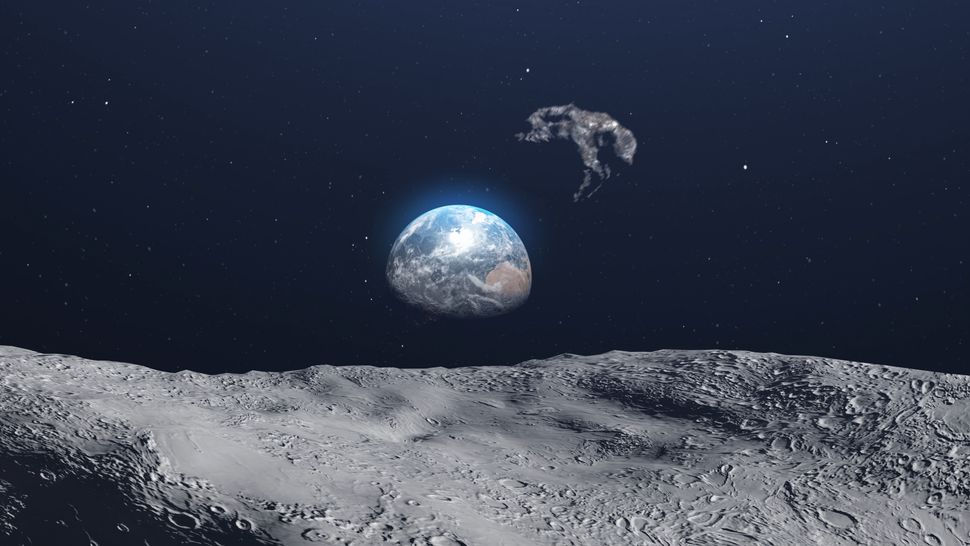'City-killer' asteroid 2024 YR4 could hit the moon instead of us, scientists say
Asteroid 2024 YR4 has a 2.3% chance of hitting Earth in the year 2032. But according to new estimates, it may have an even smaller chance of hitting the moon instead.

An asteroid that's big enough to wipe out a city has a 1-in-43 chance of hitting our planet in the year 2032. But according to new calculations, there's an even smaller chance that it might crash into the moon instead.
On Feb. 7, NASA scientists increased the likelihood of asteroid 2024 YR4 colliding with Earth on Dec. 22, 2032, nearly doubling the odds from 1.2% to 2.3%.
The potentially hazardous asteroid measures an estimated 180 feet (55 meters) across — about as wide as Walt Disney World's Cinderella Castle is tall — and is traveling at nearly 30,000 mph (48,000 kph). Although it is too small to end human civilization, 2024 YR4 could still wipe out a major city, releasing about 8 megatons of energy upon impact — more than 500 times the energy released by the atomic bomb that destroyed Hiroshima, Japan. But what if it hurtled into the moon instead?
David Rankin, an operations engineer for the University of Arizona's Catalina Sky Survey, revealed in a post on Bluesky that the asteroid also has a 0.3% chance of hitting our natural satellite. The effects of this unlucky collision would likely be visible from our planet — although we, ourselves, would probably be unaffected.
"There is the possibility this would eject some material back out that could hit the Earth, but I highly doubt it would cause any major threat," Rankin told New Scientist.
That does not mean we wouldn't see it. Rankin told Live Science that, based on current estimates, a collision with the moon could release more energy than 340 Hiroshima bombs. "It would likely be very visible from Earth," he said.
However, Gareth Collins, a professor of planetary science at Imperial College London, told New Scientist that "we would be quite safe on Earth." He added that any material ejected from the collision would likely burn up in Earth's atmosphere.
Get the Space.com Newsletter
Breaking space news, the latest updates on rocket launches, skywatching events and more!
Related: How many space rocks hit the moon every year?
Throughout its history, the moon has been subject to countless asteroid bombardments, as can be seen by its crater-pocked surface. However, if the moon were to take the hit from 2024 YR4, it would be left with a crater up to 1.2 miles (2 kilometers) across, New Scientist reported. (That's just a pothole compared with the moon's largest crater, the South Pole-Aitken basin, which spans more than 1,500 miles (2,400 km) in diameter.)
The probability of the space rock hitting either Earth or the moon is still very low, and an international team of scientists has been granted emergency use of the James Webb Space Telescope (JWST) to learn more about the space rock's size and trajectory before it leaves Earth's view for the next few years.
So far, astronomers have only observed 2024 YR4 using telescopes on Earth, and they've estimated its size by measuring the amount of light that bounces off the asteroid. But this is a fairly imprecise estimate. Instead, JWST will measure the heat emitted from the asteroid itself, which will create a much clearer picture of the asteroid's size and surface composition.
"As of now, there is still a 97.9% chance of a miss with respect to Earth," Rankin told Live Science in an email. "When the odds doubled from 1% to 2%, this caused a lot of noise. It's not the same thing as going from 40% to 80% though. This asteroid is nothing to lose sleep over."
Join our Space Forums to keep talking space on the latest missions, night sky and more! And if you have a news tip, correction or comment, let us know at: community@space.com.

Pandora is the trending news editor at Live Science. She is also a science presenter and previously worked as Senior Science and Health Reporter at Newsweek. Pandora holds a Biological Sciences degree from the University of Oxford, where she specialised in biochemistry and molecular biology.
-
Aldebaran5 " about as wide as Walt Disney World's Cinderella Castle is tall"Reply
What is the target audience of this article anyway? 12 year old girls? -
COLGeek Reply
How many elephants is that? I can't find my decoder ring...Aldebaran5 said:" about as wide as Walt Disney World's Cinderella Castle is tall"
What is the target audience of this article anyway? 12 year old girls? -
Unclear Engineer Aw, come on - pity the poor journalist trying to make an analogy for a measurement in meters that U.S. basement-dwelling gamers can relate to. If it's not the size of a football field, there is probably a frantic Internet search for the dimensions of things that might be near the same size. But, maybe they could standardize on Rapunzel hair lengths, though.Reply -
Classical Motion I think it is possible to disrupt earth with a moon asteroid collision. If it disrupts the smooth acceleration of our tides it could do great damage. If the collision effected the center of moon g, then our tide inertia will be upset. A phase change, might take months to smooth out.Reply
It’s not a planet killer, but it could certainly say hello. -
billslugg Moon mass = 7.3e22 kgReply
Moon speed in its orbit = 986 m/s
Moon's kinetic energy before asteroid strike = 3.549e28
Diameter of 2024 YR4 = 100 m
Mass of 2024 YR4 = 2.4e9 kg
Impact speed of 2024 YR4 = 1.73e4 m/s
Kinetic energy of asteroid = 3.5e17
The kinetic energy of the asteroid is but 1 part in 1e11 of the Moon's. The change in speed of the Moon would shorten the lunar month by 24 microseconds. This is insignificant to our daily lives. -
Classical Motion That's assuming the Moon is solid. What if it's hollow? And you punch a hole in it? Or the innards fall out? What if it's pressurized? Or deflates.Reply
My supposition about the Moon is not reference on this rock. If our Moon gets disturbed, it could cause great havoc here for us.
It might be impossible to live near ocean water without a moon.
That's all. Our Moon needs protecting too. -
Unclear Engineer I am not understanding why Billslugg is comparing kinetic energy instead of momentum.Reply
Much of the asteroid's kinetic energy will be lost to heating of the materials, which is then radiated to space. Some of it might be turned into ejecta, which might push in a somewhat different direction from the impact direction, unless that happened to be straight "down". So, the kinetic energy is not going to be conserved in the Moon's orbital motion, anyway.
Assuming an "inelastic collision", the momentum of the asteroid would be added as a vector (direction as well as speed time mass) to that of the Moon. So, depending on where it hit the Moon, it might extremely slightly slow it down, speed it up or change its direction by an amount of speed determined by the ratio of their masses times the asteroid's speed of impact, which is a velocity change of only 5.6e-10 m/s that might go in various directions, depending on where the asteroid hit.
The Moon is currently averaging 986 m/s, so the change would be by only 5.8e-13 of the Moon's current velocity and might be plus or minus.
Without going into the orbital mechanics, the difference in the time that it takes the Moon to make one orbit of Earth could roughly change by 5.8e-13 x 29.53 days = 1.5e-6 seconds.
That slight of a change is simply not going to be noticeable on Earth, other than by extremely precise astronomical observations. Tides on Earth are not so regular, anyway. Winds and eddies in ocean currents change sea levels from place to place all of the time, compared to what they would be from purely astronomical influences. And the astronomical influences, including the tilts of the Earth's axis and the Moon's orbit relative to the plane of Earth's orbit around the Sun, plus the elliptical nature of the Moon's orbit and the Earth's orbit, combine in a manner that already produces net cycles with a period of about 18.6 years. See https://www.coastalwiki.org/wiki/Long-period_lunar_tides. And, that cycle is not precisely repeating, either.
So, life on Earth is already adapted to much larger changes in the tides. -
Classical Motion The earth has adapted to changing tides. And will. But as far as we know, we have always had that anchor.Reply
What kind of tide pattern would result with no moon at all?
With the positions of the land, would a tide pattern EVER occur?
It might result in a continuous non pattern. Chaos oceans. With extreme currents. -
billslugg Reply
It doesn't make any difference what is inside the Moon, what shape it is or what it is made of. Its mass is measured by how long it takes an object to orbit it. If you want to challenge the mass number, I recommend you call NASA at 202-358-0001 and just rip them a new one.Classical Motion said:That's assuming the Moon is solid. What if it's hollow? And you punch a hole in it? Or the innards fall out? What if it's pressurized? Or deflates.

